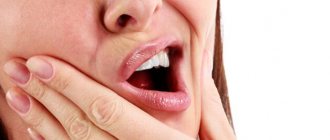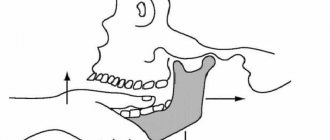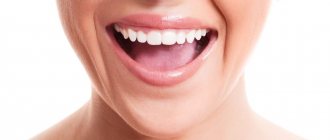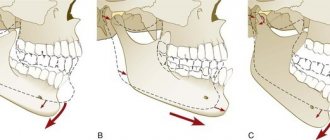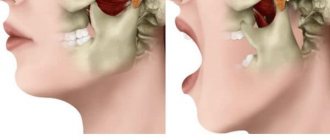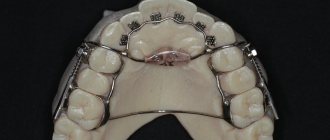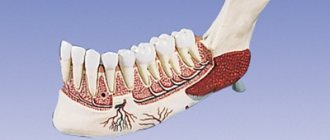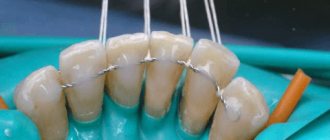Causes
The causes of displacement of the jaw joints are most often external influences. Each person has different anatomical features and the strength of fixation of the joints in the bursa. Therefore, in some people, even a minor bruise can cause subluxation. This is usually caused by weak bone tension and weakened ligaments. But also the causes of the disease are:
- rheumatism;
- epilepsy;
- arthritis (advanced stage);
- consequences of encephalitis;
- convulsions;
- joint deformation, osteomyelitis.
Factors that increase the risk of subluxation are also separately identified:
- mechanical injuries, strong impacts;
- congenital deformities, pathologies of the articular cavity;
- opening the mouth too much when biting or yawning;
- bad habits (opening bottles with teeth, habits of gnawing nuts and seeds).
The main symptoms of dislocation of the lower jaw in adults
A dislocated jaw is a displacement of the articular head that impairs its functioning.
The main signs of jaw dislocation are limited bone mobility and pain. Types of dislocations:
- unilateral - a rather rare phenomenon, accompanied by displacement of only one articular head;
- bilateral - the most common type, characterized by the inability to speak normally and swallow food;
- complete - this is the exit of the entire head from the articular cavity;
- incomplete dislocation, which in turn is divided into posterior and anterior;
- habitual.
The causes of dislocation include: diseases with joint deformation (rheumatism, arthritis), bad habits (opening bottles with teeth, cracking nuts) and mechanical stress (direct blows, falls).
How to behave after the reduction of a dislocated lower jaw and methods for preventing this condition will be discussed below.
Classification
Jaw subluxations, depending on the type and causes of development, are usually classified into the following types:
- lateral with the head moving sideways in relation to the location of the articular fossa;
- posterior with the head localized in the posterior part of the articular capsule;
- anterior with placement of the articular head immediately in front of the recess.
Most often, the anterior form of subluxation is diagnosed, which is associated with the anatomical structure. There are also two types of pathology - unilateral and bilateral. In the first case, there is a deviation only to the left or right side in relation to the jaw or temporal bone. In the second case, displacement of both joints is observed.
The simple form of subluxation is characterized by slight displacement, treatment is simple, and the patient does not feel severe pain. In a complex form, not only displacement is diagnosed, but also soft tissue disorders and ligament ruptures.
Why does your jaw crunch and what to do?
What to do if your jaw cracks?
Problems of the dental area are not limited to caries or inflammation, malocclusion or deviations,
associated with short bridles.
Temporomandibular joint dysfunction (TMJ) is another type of disorder. This paired organ carries out its activity more often than others, participating in all mobile processes, yawning, chewing, and sound reproduction. It is not surprising that with such activity of the joint, certain manifestations of imbalance in its work are not something exceptional; in one form or another they occur in many people. Problems with the functioning of the lower jaw complicate not only the chewing process. The condition of this area is very important for a person’s overall well-being. Difficulties with nutrition lead to disruption of the functioning of other organs and systems of the body, and contribute to psychological stress. If you notice at least one of the questionable signs, contact a specialist dentist-gnathologist. Solving a medical problem at an early stage always ensures a more successful result and a speedy recovery.
During the consultation, the specialist will conduct an examination, functional tests, and prescribe further diagnostic tests. The results obtained will become the basis for drawing up an individual treatment plan.
Clinical symptoms indicating a dysfunction of the TMJ.
The very first sign that people pay attention to when there are problems with the functioning of the temporomandibular joint is noise. Patients describe it as a crunching, grinding, clicking sound in the jaw when opening the mouth. The resulting popping sound represents the displacement and return to normal position of the disc located between the fossa of the temporal bone and the head of the mandible.
Many people get used to this sound, consider it a variant of the norm, and stop
pay attention.
However, such indifference to the problem lasts until pain joins the clicking, or other pathological signs are detected. We are talking about the development of such symptoms:
- Pain in the ear when opening the mouth;
- Shift of the jaw to the side relative to the median position.
- Pinching of the jaw when opening the mouth, its jamming.
- The appearance of pain in the jaw after increased exercise, the end of a long meal or a long speech.
- Signs of emerging changes in bite (underbite) as a result of pathological abrasion.
- Teeth grinding, both during the day and at night (bruxism).
- Headache, dizziness, pain and pressure in the ears.
The main causes of symptoms in the form of clicking in the joint.
Clicking in the mandibular joint is just one of the symptoms of damage to the temporomandibular joint. The specialist’s task is to clarify other nuances of the manifestation of pathological signs, identify the cause of their development, and then develop treatment tactics. If your jaw is crunching, you already know which doctor you should see. It is the dentist-gnathologist who will be able to provide effective assistance in this matter, clearly determine the nature of the existing symptoms, conduct a diagnosis and prescribe treatment. The main reasons for the development of pathological signs associated with joint damage:
- Dislocation of the TMJ, other types of traumatic lesions, bruises, cracks,
fractures of the jaw bones. - Bruxism, excessive tension or spasm caused by increased nervousness and stress.
- Malocclusion.
- Periodontitis and tooth mobility.
- Pathological abrasion
. - Poor quality work by the dentist, incorrect placement of the filling.
- Incorrect prosthetics with bridges and crowns.
- Absence of teeth for a long time, which leads to load shifting.
- Using incorrectly made dentures.
- Bad habits like chewing only on one side.
If your jaw crunches when chewing and you don’t know which doctor to see, use. Our specialists, relying on a whole range of modern research, will be able not only to make the correct diagnosis, but also to prescribe effective treatment. Depending on the nature of the lesion and the severity of symptoms, treatment for clicking in the jaw when opening the mouth can be either conservative or surgical.
Conservative treatment.
Treatment prescribed by a gnathologist is usually comprehensive and is aimed at different parts of the pathological process. It will be especially effective in cases where it is possible to identify the causes of operational failures.
- If joint damage is the result of poorly installed
orthopedic design, then to improve the situation it is necessary to undergo repeated prosthetics. - The same should be done in the case of an incorrectly installed seal, up to and including re-sealing.
- To improve the closure of the dentition, it is possible to grind off the hard tissues of the teeth that prevent this.
- If the imbalance in the joint is due to orthodontic problems, orthodontic treatment will be required.
- If there is a change in the height of the bite (decrease) due to pathological abrasion and bruxism, various types of splints (splints) are used.
If conservative methods are ineffective, in difficult situations they resort to surgical intervention.
Surgery.
In complex cases of bone ankylosis, only surgical intervention is indicated, which consists of restoring the functions of the joint by eliminating bone deformities.
The surgeon performs an osteotomy of the mandibular ramus and subsequent arthroplasty of the temporomandibular joint. The resulting defect is replaced with a bone autograft.
After completion of such an operation, to maintain surgical correction for an extended period of time, from several months to several years, exercises aimed at ensuring correct movements of the lower jaw will be required. The scale of the actions taken is evidenced by the fact that in the future patients are forced to resort to mentoplasty - surgery to eliminate defects in the chin and face shape.
The services of a surgeon may also be required if the head of the mandible is dislocated. The essence of the procedure is that the specialist returns it to the joint capsule and applies a fixing bandage to the lower jaw for several days. A gentle diet will also help to create rest for the organ and speedy rehabilitation. To limit yourself to such treatment tactics, the patient should see a doctor as quickly as possible after the injury. Old dislocations will be more difficult to correct. In these cases, surgery to reconstruct the joint may be required.
Cost of treatment at a gnathologist dentist.
The cost of services for a gnathologist dentist in Moscow varies widely, including
is largely determined by the financial policy of the center. However, high prices do not always reflect the professional level of the doctor or the diagnostic capabilities of the clinic, and the choice of treatment tactics and the success of all dental care often depend on the quality and reliability of the research performed.
To exclude unsatisfactory results of the prescribed procedures, contact the Dentist clinic. In this case, you can reliably count on the highly qualified services of a gnathologist dentist who has extensive experience in this area. In our center it will be possible to carry out a complete diagnosis of the temporomandibular joint using modern techniques, as well as go through all stages of treatment.
Additional motivation will be a lot of positive reviews about the activities of the clinic’s specialists and a free consultation.
Symptoms
Symptoms may be specific to each individual case, but in most cases the following signs of subluxation are observed:
- pain syndrome of varying intensity;
- problems with making multidirectional movements;
- excessive secretion of saliva.
Common symptoms include the following:
- the mouth is constantly open, since normal closing of the jaws is impossible;
- swelling in the ear area;
- constant headaches;
- speech disorders.
The following signs indicate the development of bilateral subluxation:
- pain and swelling in the ear area;
- displacement of the lower jaw towards the larynx;
- You can’t open your mouth;
- the patient has difficulty breathing and cannot lie down;
- speech disorders.
With lateral displacement, the following symptoms are noted:
- slurred speech;
- pain;
- visual displacement of the jaw to the right or left.
First aid measures
Treatment is provided in the clinic using conductive or infiltrative jaw reduction. But the patient’s condition can be alleviated by providing first aid:
- the patient must be reassured;
- the jaw is fixed in any available way;
- for severe pain, it is recommended to give analgesics.
Treatment of subluxation
Treatment involves the need to realign the joint, that is, return it to the glenoid fossa. Various methods are used for this:
- Hippocratic method. It is performed only by the orthodontist, who faces the seated patient. Local anesthesia is first administered, after which the doctor applies pressure to the molars with his fingers, grasping the jaw with his palm. When a click appears, the joint is put in place and the jaws close. A sling-shaped bandage is applied to the jaw area; it is recommended to limit the load for two weeks.
- Papescu's method. It is carried out when the pathology is advanced, it is carried out in a horizontal position, that is, the patient must lie down. If necessary, local or general anesthesia is performed.
Treatment prognosis for timely treatment is good, the joint goes into place and does not bother the patient in the future. Rarely, repeated displacement and stiffness of the jaw is possible.
Treatment of jaw dislocation
A dislocated jaw is treated simply: the doctor realigns the joint, placing the bone in the right place. Muscle relaxants or painkillers may be needed to relax tight muscles.
Then the jaw must be secured in a stationary state. To do this, the doctor applies a bandage. If the dislocation does not appear for the first time, then surgery will be needed to straighten it.
Recovery after a dislocation lasts 6 weeks. At this time, you should not open your mouth wide. When yawning and sneezing, the lower jaw should be supported with your hands.
Complications
If the patient promptly sought medical help and strictly followed the recommendations while wearing the splint, then the outcome is favorable. In this case there should be no relapses. But early load on the jaw and the presence of deforming joint diseases can provoke a relapse, and, as a rule, more than one.
Make an appointment with our specialists and find out first-hand the main symptoms of a dislocated lower jaw. Remember that only qualified medical care will help you get rid of the problem for a long time and enjoy all the joys of life.
Related services: Dental implantation Treatment of temporomandibular joint disorders


